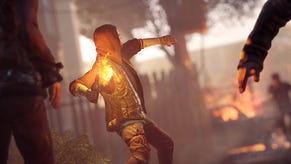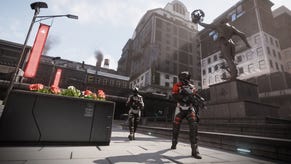Homefront – multiplayer preview and developer interview with Kaos Studios
Kaos Studios’ Homefront was one of the more pleasant surprises from US publisher THQ at E3 earlier this year. A genuinely intriguing new wargaming IP to take on the might of Activision’s Call of Duty franchise. Whether or not there is room in this crowded market for a game of this ambition and magnitude remains to be seen. Homefront releases next March on PS3, Xbox 360 and PC.
VG247 was treated to a first-look at two of the game’s multiplayer levels at a preview event in London recently, with a bunch of genuinely innovative new features revealed.
We also managed to grab a one-to-one chat with Kaos Studio’s community manager to find out a little more about the background to some of these new multiplayer elements, such as Battle Points and Ground Control. And to quiz him a bit more about the background behind the game’s barking mad storyline, in which a pan-Asian mega-army lead by North Korea takes over America in the near future…
Firstly, you will most likely already be familiar with some of Kaos’ past games such as Frontlines: Fuel of War or the Desert Combat mod for Battlefield: 1942. Both of which stands them in good stead for producing a solid multiplayer war-gaming experience.
The two multiplayer levels we were introduced to last month successfully showed off the many elements to the game, with a close-knit infantry and drone-heavy battle in an eerily-quiet typically all-American suburb followed by a more vehicular-heavy clash in and around a farm-based level. Homefront seems to tick all the right boxes, for anybody who wants fast-paced future-war multiplayer action (and who, for whatever reasons, doesn’t want to play Call of Duty!). There are two new features that Kaos has introduced on top of all the usual stuff that the devs hope will really make Homefront stand out from the many other similar-looking experiences already on offer.
The first one is called Battle Points, with players receiving extra BP for killing the enemy and for helping their own team by capturing locations or by strategically assisting team-mates to take down opponents. Battle Points also promote closer team-work in the game. The more BP you accrue, the bigger and better weapons you can buy – so the key is not to blow it all as soon as you get it, but to try to save as much as you can. And then buy yourself a massive tank or an apache helicopter and blow the whole level to kingdom come!
Kaos also unveiled a new Ground Control mode, which generates three capture points on the map and – once either team has captured these – spawns three new capture points in different areas. It’s an ingenious way of keeping things fresh.
Overall, the sensation you take away from the initial encounter with Homefront multiplayer is that it is incredibly fast, with fluid, frenetic gameplay that the developer’s claim will always be changing and new enough to never get boring or samey. There are a few balancing issues that need to be sorted out with the driving controls (which were way too difficult) and the graphics obviously need a lot of work, but this is a game at pre-alpha level in development, so all of that is pretty much par for the course.
So after a brief stint of getting my arse kicked into touch on the two multiplayer levels on show – the all-American suburb and the farm-based levels – I managed to speak to Jeremy Greiner, Community Manager for Kaos Studios and Homefront to find out a little bit more about why Kaos and THQ think they have something particularly new and special for multiplayer war-gaming fans with Homefront.
VG247: Homefront was something of a surprise hit at E3 2010. The game came from out of the blue for a lot of people. Why do you think that was?
Jeremy Greiner: Well I think that THQ is fully committed to putting out a triple-A blockbuster experience with Homefront, both with the single-player game and the multi-player experience. We showed the first slice of Homefront single-player on console at E3, and, subsequently, on PC at Gamescom in Germany. And it was, I think, wholeheartedly successful because we sold our universe well.
We have this resistance fighting mentality in occupied America, right? The E3 demo – which was called Oasis – was a level which showed you the universe and showed you the human cost of war. It showed you what people were going through to survive. Most importantly, not a single bullet was fired in that level. And the response that we got from showing that first level was phenomenal. People just got it. They got the immersion, they got the universe, they got the story. I mean, if they didn’t get it, that would have been a pretty boring level right, with no bullets fired!?
And then the next level we showed was called Malice, which gives you the killer fps action that everybody is looking for, with great cinematics, great fire-power, lots of cool gunfights and so on. So I think it was because we delivered on both elements of the single-player story and the gameplay with that E3 demo that was why it lived up to the billing and, in fact, probably exceeded it.
The game was soon being likened – somewhat obviously – to the Call of Duty series. But there have also been mentions and comparisons with a number of other massive triple-A classics such as Half Life.
Greiner: Honesty, you know, we’re more than happy to be mentioned in the same sentence as those killer IPs out there! Homefront right now is a first run. But we are fully dedicated to delivering that triple-A quality experience. So it’s good that we’re mentioned in that light.
So to talk a little bit more about the multiplayer experience, which we’ve had our first taster of today, the introduction of Battle Points seems to be a key element or feature.
Greiner: Yeah. In any production, or pre-production process, you go through the design phase and you look at various options and ideas for what you think might work as cool features. A lot of them get dropped and don’t live up to the billing. Some of them do live up to the billing. And very rarely does a feature actually exceed expectations. Battle Points did. And this is because it delivers on three major principles that show through in gameplay.
Firstly, escalating intensity. We don’t start out with vehicles spawning on the map, so players have to save their Battle Points in order to buy something – so they might choose to buy a small drone earlier on in the round, or save up their points in order to buy an Apache or a larger vehicle later on in the round and reign havoc from above – so that falls into the ‘save or spend’ type strategy. You cannot buy anything straight off the bat, which gives the action in the multiplayer game a natural tendency to build and build and build and build, as players purchase bigger and better vehicles. And then what happens is that as both teams develop and obtain more and you have multiple air-to-air battles, air-to-ground battles – all with infantry mixed in. So Battle Points lends itself well to many aspects of the multiplayer gameplay.
It is a big win for gamers, because it also promotes team-play. A lot of the time – and specifically in our genre - you are rewarded for individual accomplishments. Whereas with Battle Points you are rewarded for team accomplishments. So a guy doesn’t necessarily have to be the best player and roll-up a ten-kill streak in order to have access to all the great weapons and vehicles that we have. He can instead concentrate on helping his team achieve their objectives, and earn Battle Points in that way.
In addition to Battle Points, what would you say are the other key features of Homefront multiplayer?
Greiner: We also showed off our Ground Control game mode today, which helps to generate a dynamic map and promote a dynamic multiplayer experience. It’s not static in any way. A lot of the time you get combat fatigue in a game, right? You are always in the same area and you kind of do the same things out of the gate each time around. In Homefront, because of the spawning vehicle system, along with Battle Points and Ground Control, you are always doing something new and different.
The concept of Ground Control is that there are multiple points on a map in a line, which you start oppositely on, on either team. So it is not that usual ‘A, C tug of war for B’ scenario, because if you spawn on either side it is more cyclical. It is more like a merry-go-round. And it is quite subtle and not something that you might have noticed immediately when you were playing, but you never feel like you are holding one point. And what happens is, as the team accrues points and hits the limit they win the round and then that line of capture points moves to another place on the map.
So that goes back to the combat fatigue. You don’t get it with Ground Control, because you move to a new place on the map which has different sightlines, different cover points and so on and makes you play completely differently. So on the farm level, for instance, which starts out in the wide open – as that line moves it goes into an industrial area which is much better for infantry combat and smaller drones and so on.
So we have seen that typically all-American suburb level and the farm-based level today – what other types of environments are we likely to see in Homefront multiplayer?
Greiner: So multiplayer will go hand-in-hand with our single-player storyline and our Homefront universe. You will see a lot of ‘the familiar becoming alien’ in our maps. You will see a lot of urban and suburban city environments. Today we picked this particular slice to pretty much introduce you to it, as it is a good way of introducing you to the infantry controls, the Battle Point system and the drones in the game. And then we showed you the farm level, which is that epic vehicular warfare that everybody expects out of Kaos.
The storyline is obviously a major aspect to Homefront - to the single-player game especially – can you tell us more about the background to the concept and how the idea was developed into the final story?
Greiner: Our creative director Dave Votypka originally had the high-level concept for Homefront. Dave asked a colleague at THQ if he could help him develop the creative process and he was referred to – and asked if he would like to work with - John Milius. And he was like, “err, yeah!” [John Milius, for those that don’t know, is a leading Hollywood screenwriter, who wrote Conan The Barbarian, Apocalypse Now, Red Dawn and too many other modern classics to list here].
So those two worked together. And then in order to build our future history to work as best as it could with the overall scenario, asking “what if X, Y or Z happened?”, we enlisted a CIA operative to help sculpt and develop that future history/what if scenario. So what we have done is to put together a sequence of events that, while not probable, are still plausible – and that is why everybody is so immersed in it and it actually lends itself really well to other mediums in addition to gaming, so we have a lot of ideas on that front. Watch out for some big announcements on that soon.















.jpg?width=291&height=164&fit=crop&quality=80&format=jpg&auto=webp)
